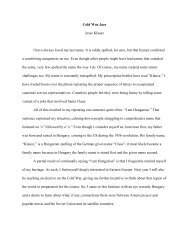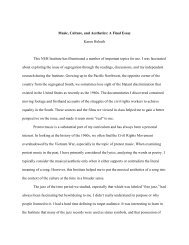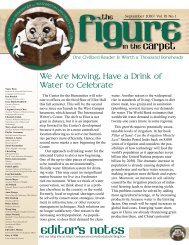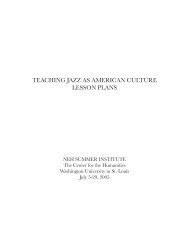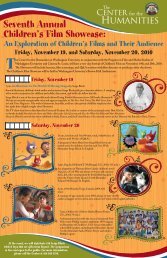You also want an ePaper? Increase the reach of your titles
YUMPU automatically turns print PDFs into web optimized ePapers that Google loves.
132Mike CaddenWalsh is “responsible to nobody” (“<strong>The</strong> Writer’s Responsibility” 32) exceptto <strong>the</strong> book itself as artistic product (35). But <strong>the</strong> creation of ethicalart isn’t limited to those with specific notions of a child audience or tothose who have generalized notions of children. 3 It is entirely possible thatwhat one writer considers a matter of audience, ano<strong>the</strong>r writer withoutrhetorical concerns might find to be a textual feature of children’s books.If Walsh doesn’t consider children as she writes her children’s books, she<strong>the</strong>n writes with an eye focused on generic tradition. For her to write whatshe considers “children’s literature” while ignoring a sense of audiencenecessarily means that her guideline—her context—is genre, however sheperceives it.Both writers are known for <strong>the</strong>ir hopeful yet unflinching social realism.Paterson’s self-consciousness about an audience is <strong>the</strong> reason she writeshopeful literature; Walsh writes hopeful realism for her own reasons apartfrom audience considerations, though it works as children’s literatureowing to, in part, <strong>the</strong> presence of this feature. Ethical art is art,none<strong>the</strong>less. Wayne Booth argues that “<strong>the</strong> distinction between genuineliterature (or ‘poetry’) <strong>and</strong> ‘rhetoric’ or ‘didactic’ literature is entirelymisleading if it suggests that some stories . . . are purged of all teaching”(151–52). <strong>The</strong> idea that all good art is ethical enables writers for childrento serve both text <strong>and</strong> context . . . or <strong>the</strong> two traditionally dem<strong>and</strong>ingaudiences of children <strong>and</strong> children’s literature. We see <strong>the</strong> same conflationof audience <strong>and</strong> art, text <strong>and</strong> context, ethics <strong>and</strong> genre in Le Guin’s selfcriticaldiscourse.<strong>The</strong> idea of <strong>the</strong> crossover writer—<strong>the</strong> writer who writes for bothchildren <strong>and</strong> adults—has been on children’s literature critics’ minds lately.Not much had been said about crossover writers before <strong>the</strong> special issue of<strong>The</strong> <strong>Lion</strong> <strong>and</strong> <strong>the</strong> <strong>Unicorn</strong> in 1978. David Galef has reintroduced <strong>the</strong>matter with his argument that “an equally complex but perhaps morefruitful query than [‘What is a children’s book?’] is ‘What enables anauthor to write both children’s books <strong>and</strong> adult fiction?’” (29). Critics areseeing <strong>the</strong> worth of examining <strong>the</strong> nature of children’s literature at <strong>the</strong> siteof <strong>the</strong> successful crossover writer because such writers actually perform<strong>the</strong> genre distinctions in question. Mitzi Myers’s question about <strong>the</strong>crossover writer seems a natural one to ask of Le Guin: “[W]hatcontinuities or divergences mark <strong>the</strong> writings of those who create separateworks for child <strong>and</strong> adult?” (120).Le Guin, like Paterson <strong>and</strong> Hunter, is concerned with <strong>the</strong> real live childaudience who reads her books. She describes her duty to her muchyounger audience by defining what she won’t do in <strong>the</strong> particular genre ofchildren’s literature:



